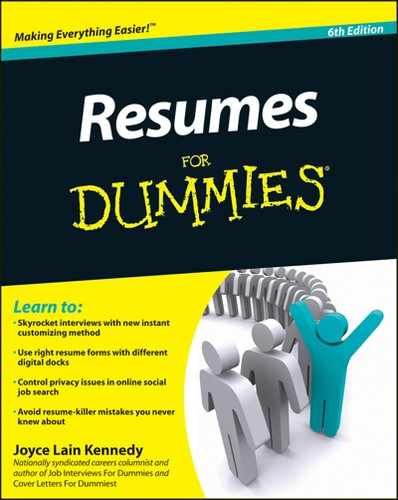Chapter 6
Target! The Generic Resume Has Nearly Dropped Dead
In This Chapter
![]() Selling yourself as custom match for each job
Selling yourself as custom match for each job
![]() Moving instantly with Plug-and-Play resumes
Moving instantly with Plug-and-Play resumes
![]() Tailoring your resume from A to Z
Tailoring your resume from A to Z
Your old one-size-fits-all resume is dated, obsolescent, moth-eaten, passé, antediluvian, and otherwise dumpster-ready.
Blame it on technology. Today’s employers are drowning in digital resumes because job seekers find them so easily clicked and sent — and send them they do! By the hundreds, by the thousands, by the millions! What’s a resume-soaked employer to do?
The 21st Century Resume Rush has caused most companies to use an automated applicant tracking system (ATS) to make the first cut of people applying for a job opening. After the software separates the possible from the worthless, human eyes take over. Recruiters surf the surviving database of possible hires to identify the best matches of candidate and job. After additional cuts, only the last candidates standing get the recruiter’s interviewing nod.
This chapter explains why your resumes go missing and reveals new time-saving techniques to increase your odds of making it over early hurdles.
Targeted Resumes Conquer Generics
When you’re on the outside looking in at recruiting gates and going nowhere, suspect that your standard-issue generic resume is stopping you cold. Once a staple of job search, today’s generic resume model has become merely a shot in the dark, ricocheting about a murky marketplace of endless competition — a shot far more likely to miss than hit your target. This is especially true if you’re on the high end of the age scale, or have been unemployed for a long while.
When you’re tired of being kicked around in the job market, reflect on the differing initial impressions a generic resume and a targeted resume make:
![]() A generic resume is candidate-centered.
A generic resume is candidate-centered.
Translation: Here’s my resume, Mr. or Ms. Employer. Hope you can find something you like about me. I’m too busy and I lack motivation to show you exactly why you want to hire me. You’re on your own. Good luck. Signed: No one you ever heard of.
![]() A targeted resume is employer-centered.
A targeted resume is employer-centered.
Translation: Glad to see you, Mr. or Ms. Employer. I’m so right for your job I’ve gone the extra mile to make it easy for you to spot the fabulous match between my qualifications and your job’s requirements. I promise it will be well worth your time to look me over more closely. Signed: Someone you want to meet.
With the exception of a handful of situations (see the sidebar in this chapter, “Special cases when going generic is okay”), the all-purpose resume is in a hearse headed for a final resting place behind history’s hill. Rather than join the funeral procession, discover the rewards of creating a customized, targeted resume for each job you seek.
This chapter emphasizes how to do just that with the least fuss and muss. It reveals two Custom Lite approaches that deal in quick fixes. In contrast, the Full Custom approach requires a more comprehensive makeover.
By boosting the odds, you won’t be screened out before you get a chance to interview; both the Custom Lite and Full Custom approaches can put new fire in the belly of your job search.
Welcoming a Custom Lite Approach
In case you’re wondering how the generic resume became the norm, national career expert Peter Weddle explains that way back when the typewriter was king, customizing resumes was a time wipeout — like re-chiseling a statue.
Even though the computer age is upon us, fully customizing a resume remains a time-sucker in busy lives — like preparing a five-course meal from the beginning. That’s why you want to check out two quick-fix Custom Lite treatments to tailor your resume for each specific employment opportunity:
![]() The first technique is based on design; the recruiter gets a glimpse of your matching value at first glance.
The first technique is based on design; the recruiter gets a glimpse of your matching value at first glance.
![]() The second technique is based on words; the recruiter grasps your matching value at first read.
The second technique is based on words; the recruiter grasps your matching value at first read.
Design-based approach: Two columns
The two-column resume — also called a T-resume or ledger resume — is a custom quick fix that immediately tells recruiting eyes: “I have exactly what you’re looking for.” The two-column layout is appropriate for most resumes, other than top executive resumes and academic CVs.
A popular treatment of the two-column resume opens with a summary featuring bullets:
![]() The left column of a ledger design is typically titled something along the lines of “You Ask For” or “Company Requires.” It identifies the position’s requirements — the qualities and capabilities a given employer seeks to hire.
The left column of a ledger design is typically titled something along the lines of “You Ask For” or “Company Requires.” It identifies the position’s requirements — the qualities and capabilities a given employer seeks to hire.
![]() The related right column of a ledger design typically has a title like “I Offer,” or “I Deliver.” It confirms the job seeker provides the specific requested qualifications.
The related right column of a ledger design typically has a title like “I Offer,” or “I Deliver.” It confirms the job seeker provides the specific requested qualifications.
The remainder of a two-column profile design is identical to the remainder of a generic resume.
I illustrate the two-column look with a pair of first pages of resumes for mythical lawyer Mark Thomas. Mark’s generic resume (Figure 6-1) reflects a lawyer with general qualifications who writes to benefit himself. Contrast this document with Mark’s targeted resume (Figure 6-2), which reflects a lawyer who writes to benefit the employer.

Figure 6-1: The first page of Mark Thomas’ generic resume fails to show potential employers what they’d gain from hiring him for a specific employment opportunity.

Figure 6-2: The first page of Mark Thomas’ targeted two-column resume makes clear the benefits he offers for a specific employment opportunity.
Words-based approach: Plug and Play
If the future of snagging job interviews is in personalizing the approach, the question is, why don’t more people create targeted resumes? Probably because crafting a Full Custom resume for every job you go after is as tiring as tap dancing your way across a continent very slowly.
The answer lies in a groundbreaking approach that relies on shortcuts. The big idea is to create a starter (basic) resume of one to three pages that you change as needed to fit each job goal.
The Troutman Plug and Play Resume Method is a systematic process in which you mix and match prepared modules of personal information as a jiffy shortcut to customizing each resume. You store, sort, and speedily retrieve information as needed. And because you cut and paste, you do it fast!
Although Troutman’s Plug and Play (PnP) approach fits into the Custom Lite category, her method packs a powerful punch in targeting job searches.
After you make practice runs with the Troutman Plug and Play Resume Method, you can create a first-rate tailored resume in under an hour; I’ve seen Troutman whisk out an impressive PnP resume in 20 minutes flat.
Plug and Play Resumes in Five Easy Steps
When your time management budget won’t stretch to include crafting a Full Custom resume hearty enough to survive software and human recruiter screening, don’t give up — call PnP to the rescue with these steps.
Step 1: Create a core resume
Compile every career-related factor in your background. Include data ranging from experience and education, to competencies and skills. Everything! (For content suggestions, see Chapter 8.)
Think of your core resume as a comprehensive career inventory — a trip down memory lane. The finished product may spread over a dozen pages; no matter — only you lay eyes on this valuable resource document that saves you exasperation and time in the long run.
Step 2: Create information modules
Stockpile data on your computer in the form of personal information modules — paragraphs of autobiographical facts you copy and paste into many targeted resumes. Begin this step by drawing content from your core resume (Step 1). Add more data as needed.
![]() Keywords: Gather industry and typical position requirements for the kind of job you’re targeting: job titles, job duties, and industry jargon. Web browse for online lists of additional keywords in the same job families; try searching for “keyword generators” and “keyword lists.”
Keywords: Gather industry and typical position requirements for the kind of job you’re targeting: job titles, job duties, and industry jargon. Web browse for online lists of additional keywords in the same job families; try searching for “keyword generators” and “keyword lists.”
![]() Accomplishments: Choose accomplishments related to the jobs you’re targeting; this selectivity is especially important if you’re changing career fields. (Never say your greatest accomplishment is in a field from which you’re trying to escape.) You can create various types of accomplishment categories, such as accomplishments saving or making money for an employer.
Accomplishments: Choose accomplishments related to the jobs you’re targeting; this selectivity is especially important if you’re changing career fields. (Never say your greatest accomplishment is in a field from which you’re trying to escape.) You can create various types of accomplishment categories, such as accomplishments saving or making money for an employer.
![]() Work experience: Construct a module of your previous job titles, employers, and years worked. Focus on paid work but include unpaid work as well, especially if you’re short on the former. Internships are valuable. (Work is work, paid or unpaid.)
Work experience: Construct a module of your previous job titles, employers, and years worked. Focus on paid work but include unpaid work as well, especially if you’re short on the former. Internships are valuable. (Work is work, paid or unpaid.)
![]() Skills: Put together paragraphs naming your skills aimed at specific functions — a good start is management skills, administrative skills, budgeting skills, hard skills (the ones that help you do tasks specific to a particular job), and soft skills (the ones that help you work with people).
Skills: Put together paragraphs naming your skills aimed at specific functions — a good start is management skills, administrative skills, budgeting skills, hard skills (the ones that help you do tasks specific to a particular job), and soft skills (the ones that help you work with people).
![]() Competencies: If skills are the activities people can see you do as you work at a given job, competencies are the knowledge and experience you use to do the skills well. Compile paragraphs describing your competencies and how you use them. You can separate competencies by specific categories — work-based competencies, and behavior-based competencies, for example. (See Chapter 8.)
Competencies: If skills are the activities people can see you do as you work at a given job, competencies are the knowledge and experience you use to do the skills well. Compile paragraphs describing your competencies and how you use them. You can separate competencies by specific categories — work-based competencies, and behavior-based competencies, for example. (See Chapter 8.)
![]() Education and professional development: Assemble a module detailing a reverse chronological history of your education, including continuing education, seminars, and distance learning.
Education and professional development: Assemble a module detailing a reverse chronological history of your education, including continuing education, seminars, and distance learning.
Limit your list of professional development courses to the past five years. Your chances of remembering anything from a training course you attended five years ago are slim. Additionally, the world has changed enough to make training older than five years somewhat outdated.
![]() Credentials: Make a module identifying relevant licenses and current professional certifications. Omit any credentials from a field you hope to see only in your rear-view mirror.
Credentials: Make a module identifying relevant licenses and current professional certifications. Omit any credentials from a field you hope to see only in your rear-view mirror.
![]() Awards, honors, memberships: Record your professional kudos and memberships. For these paragraphs, select only those with relevance for your target.
Awards, honors, memberships: Record your professional kudos and memberships. For these paragraphs, select only those with relevance for your target.
When the name of the award doesn’t show its impact, tell what it was for as opposed to what it was called. Thanks to career expert Don Orlando for the following examples that illustrate this tip.
The “President’s Award” in one company may be for exceeding sales goals by 10 percent, while an award with the very same name in another company may be given for just meeting the goal. Avoid confusion by
• Showing the competitiveness of the award — relate how many people competed for it.
• Adding any unusual context — were you the only person to win the award back-to-back in the 50-year history of this honor? Say so to get full credit for what you’ve done.
![]() Organizations: A module mentioning both professional and civic membership groups to which you belong deserves careful thought, for both relevance and impact. Mention the fact if you were an officer.
Organizations: A module mentioning both professional and civic membership groups to which you belong deserves careful thought, for both relevance and impact. Mention the fact if you were an officer.
![]() Profiles: Build modules of your favorite summary profile for each kind of job you’re targeting.
Profiles: Build modules of your favorite summary profile for each kind of job you’re targeting.
![]() Endorsements: Keep a module on standby of two- or three-line testimonials (like very short book blurbs) from anyone who has seen you solve problems. Likely sources include bosses, coworkers, customers, and vendors. Endorsements from well-known individuals in a community are helpful, too. Specific comments are more powerful than generalities.
Endorsements: Keep a module on standby of two- or three-line testimonials (like very short book blurbs) from anyone who has seen you solve problems. Likely sources include bosses, coworkers, customers, and vendors. Endorsements from well-known individuals in a community are helpful, too. Specific comments are more powerful than generalities.
For more suggestions on the content of your modules, skip ahead and read content categories in Chapter 8, and read about keywords in Chapter 10.
Step 3: Create a starter resume
Select information from your core resume in Step 1 to produce a starter (basic) resume of one to three pages. (Yes, you may be able to use, with modification, your old generic resume.) Save your starter resume on your computer — it’s the foundation for all your targeted spinoffs.
Step 4: Research target job positions
When you respond to an advertised job, analyze the specific job description for employment you hope to snare. Zero in on keywords.
Alternatively, when you park your targeted resume in a job board database, or shop it around your network, study a dozen job ads to find the most common requirements for the work you want. Again, remember to use plenty of keywords.
Step 5: Create a targeted resume
Lead with strength in your PnP resume even if you have to bend some conventional rules and reshuffle your personal chronology.
For example, graduates generally start listing work experience before education on their resumes after one year of full-time work, or after their first full-time job. But in PnP resumes, a decade-old education may appear before work history in situations where a job seeker is starting over in a different career, or needs to be appreciated as a proven learner.
![]() In most situations, change the summary bullets (relevant skills) at the top of your resume’s first page to make them instantly perceived as relevant to the targeted job.
In most situations, change the summary bullets (relevant skills) at the top of your resume’s first page to make them instantly perceived as relevant to the targeted job.
![]() Sometimes — to establish immediate relevancy — you alter the chronological order of your work experience and education.
Sometimes — to establish immediate relevancy — you alter the chronological order of your work experience and education.
You may, for example, lead your work history with a job you held five years ago when the older job is a better match than a more recent job. But don’t lead with a job you held 20 years ago even when it’s a close match. Remember that recency is next to relevancy in PnP resumes.
![]() When you can’t decide whether to (a) present a strongly preferred traditional reverse chronological history with no gaps, or (b) to showcase certain relevant items by moving them forward out of traditional order, ask yourself whether altering how you present your work history or education will improve your chances of surviving the screening process.
When you can’t decide whether to (a) present a strongly preferred traditional reverse chronological history with no gaps, or (b) to showcase certain relevant items by moving them forward out of traditional order, ask yourself whether altering how you present your work history or education will improve your chances of surviving the screening process.
If your answer is “yes,” go for it! If your answer is “no,” stick to the traditional, no-gap lineup.
Plug and Play Resume Sketches
Look over the following backstory for Allen C. Trenton, followed by his three-page starter resume and its five spinoff resume sketches (one page each).
Allen’s starter resume and his five resume sketches were created by Resume-Place.com president Kathryn Troutman. (Although based on a real person, names and other identifying data have been changed for privacy reasons.)
Allen’s backstory
Thirty-three-year-old Allen lives in Baltimore, Maryland. Voluntary relocation would be a last resort. Now unemployed except for temporary work, Allen is in the career-change mode, hoping to get a job he wants with the skills and experience he already has.
While a college student, Allen began his studies and work experience at a recording studio, hoping to become a recording and sound engineer. Later he switched to selling high-end sound equipment for a prominent retail chain and continued there after graduating with a bachelor’s degree in psychology.
When, in a down economy, the retail chain shuttered a few years later, Allen discovered comparable employment wasn’t available locally. Now married, Allen decided to make a course correction and began to teach substitute classes for the Baltimore public schools. The substitute teaching assignments patched holes in his family budget, as Allen and his wife struggled to pay their bills.
In addition to his ease in communications pursuits, Allen’s managerial skills include computer systems operation, planning projects, and coordinating events.
He is scouting professional positions in a number of career fields for which he likely qualifies — positions that are interesting to him and offer employee benefits.
As soon as his employment is stable, Allen will evaluate distance learning options to earn a master’s degree in education, as well as prepare for secondary teaching certification.
Described by friends as “a walker and a talker,” Allen much prefers interacting with people to toiling alone at a desk. Allen, who can sell Christmas trees in February, is looking with creative eyes at employment opportunities in both the private and the federal sectors.
Allen’s starter resume
Allen’s starter document is the basis for each resume sketch, as described in Step 3 in the above section “Plug and Play Resumes in Five Easy Steps.” His starter resume (Figure 6-3) is the framework Allen uses to spin off customized resumes.
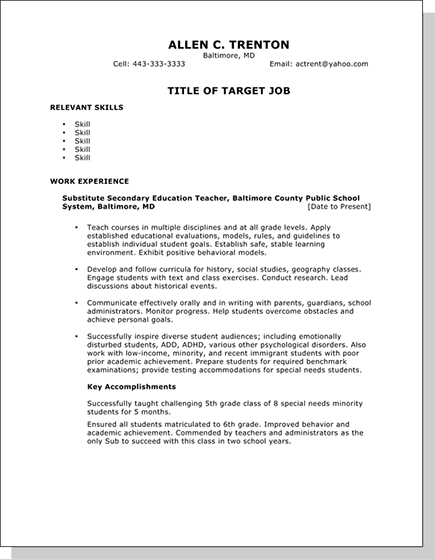
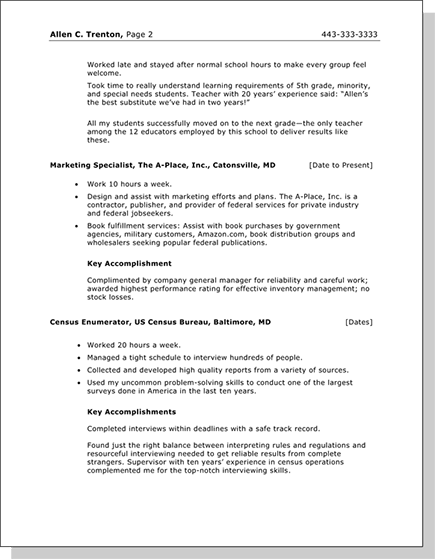

Figure 6-3: Allen’s starter resume is a framework document used for instant customization.
Spinoff 1: Permanent substitute teacher
Permanent substitute teachers earn higher pay in this school district than temporary substitute teachers. So although Allen already works as a temporary substitute, understandably he would like to transition to permanent status. Figure 6-4 shows his targeted resume sketch.
In addition to aiming his bullets of relevant skills directly at his teaching expertise, Allen’s education module appears before his work experience to highlight his intent to invest in graduate study and to acquire the required credentialing for permanent status. He displays his major, psychology, in boldface type because educators view knowledge of the science of human behavior as a plus in education. His statement that he worked while earning high grades is also viewed as a plus (think dedicated workhorse). His next module, work experience, shows valuable work experience in teaching; note key accomplishments in teaching and in interacting with a wide variety of people.
Spinoff 2: Training coordinator
Allen looks for connections between teaching children and training adults. In retargeting the relevant skills bullets, he mentions his skill with office and training software. (See Figure 6-5.) Allen leads with his education paragraph and follows with his work experience in teaching for the same reasons he did in Figure 6-4. Allen includes key accomplishments proclaiming not only does he work well with almost everyone, but he’s a standout professional who succeeded where others failed.
Spinoff 3: Background investigator
Background investigators do the kinds of things Allen identifies in Figure 6-6, which shows his resume sketch’s bullets of relevant skills for this federal job. (This is not a job for Sam Spade chasing murder suspects but a government national security function.) Although the Census Bureau job was temporary, Allen presents it first to communicate his ability to productively interact with large numbers of strangers in any setting. He follows with the substitute-teaching job because it shows that he’s currently employed. (Employers typically prefer to hire employed candidates.)
Spinoff 4: Contract specialist
The relevant skills bullets in this version of Allen’s Plug and Play resume sketch (Figure 6-7) use a lot of keywords to indicate he knows his way around negotiation and contract management. His referral to statistical analysis software (SPSS and PASW) adds to the presumption of professional competence. Allen leads with his work experience module, starting with his substitute teaching job to show he is employed. Allen immediately follows with his retail experience in the Tilling Audio-TV store, which is his strongest qualification for work as a contract specialist.
Spinoff 5: Park guide
Walker-and-talker Allen lays out his relevant skills, using many of the keywords he found in the job announcement. (See Figure 6-8.) Allen immediately follows his skills bullets with his work experience module to communicate his ease with crowds of strangers. Allen’s education module comes next to indicate his interest in dealing with information as well as with people.
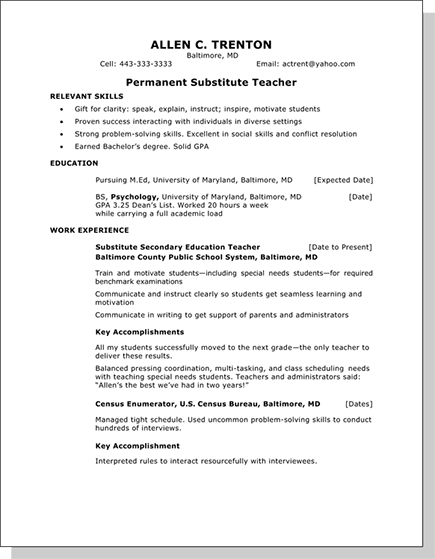
Figure 6-4: In this resume sketch, Allen’s starter resume is turned into a marketing document for a permanent substitute teaching job.

Figure 6-5: In this resume sketch, Allen’s starter resume becomes a sales tool for a training position.
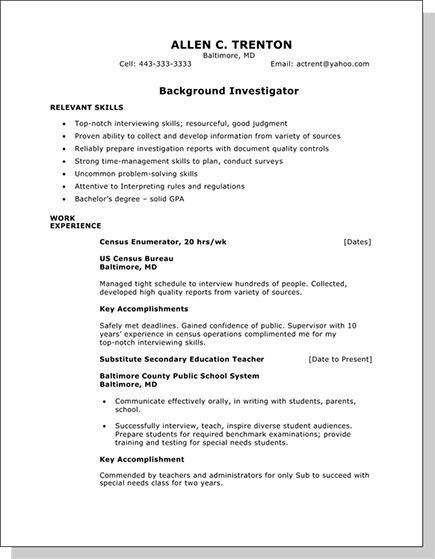
Figure 6-6: Allen’s starter resume is tailored for the job of a federal background investigator in this resume sketch.
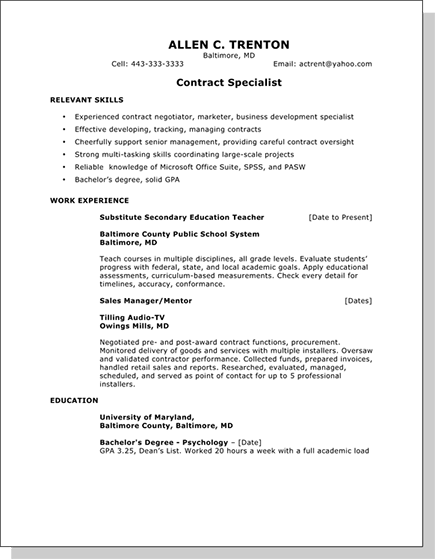
Figure 6-7: Allen’s starter resume is reframed for a contract specialist position in this resume sketch.
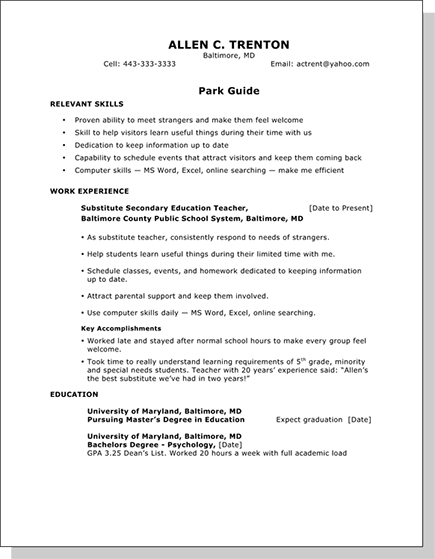
Figure 6-8: In this resume sketch, Allen’s starter resume is personalized to apply for a park guide job.
When Only Full Custom Resumes Will Work
At some points in a hunt for ideal employment, everyone needs market-driven, full-blown, totally customized job search communications.
When you come across an opportunity that can literally change your life — and you want it more than you’ve ever wanted another job — pull out all the stops and start from scratch. Put your watch in a drawer and don’t count the hours needed to do a first-class Full Custom resume in which you tell the employer such critical facts as these:
![]() How you plan to make the company more money than it costs to recruit and employ you
How you plan to make the company more money than it costs to recruit and employ you
![]() Why you are an excellent match for the job
Why you are an excellent match for the job
![]() The power of your network as it relates to the industry the company serves
The power of your network as it relates to the industry the company serves
![]() What competencies and skills you bring to the organization
What competencies and skills you bring to the organization
![]() Your good reputation and its ability to attract and keep good customers and team members
Your good reputation and its ability to attract and keep good customers and team members
![]() Your capacity for doing the work better than other candidates
Your capacity for doing the work better than other candidates
![]() Your ability to solve company or industry problems
Your ability to solve company or industry problems
![]() Why the employer should believe you
Why the employer should believe you
Step 1: Prepare your core resume
Probe your memory to jot down every factor in your background you can use to customize a resume, from experience and competencies to skills and education. You don’t submit this inventory document to an employer but you use it as a rich personal resource. Use as many pages as you need. (For pointers on content, check out Chapter 8.)
Step 2: Research requirements of the job
If you’re responding to a specific advertised job, jot down the requirements listed in the job ad. If you really want an edge, call the company’s human resources department and ask for the position description. That’s the document the company uses to evaluate your qualifications for the opening, and to evaluate you should you win the job. If you sense any reluctance by HR to provide you with the position description, ask for a copy with any proprietary information (including salary range) blacked out. Promise you’ll treat what they send you as completely confidential. Address all job requirements in your Full Custom rewrite.
Step 3: Customize your resume
After drafting the must-haves in your Full Custom resume, review your core resume to see whether you can add secondary items mentioned in the ad or position description to further improve your chances.
Is Targeting Your Resume Really Necessary?
Sprinting ahead in today’s candidate-cluttered job market gobbles up more research effort than the last time you baited your resume hooks. When there were plenty of jobs to go around, you may have needed to apply for, say, ten openings in a job search before meeting success. Now, to land a job you want, don’t be shocked to find that you have to step up your game to go after ten times that number.
What’s more, when a job opening draws your attention, respond at first light. In these tight times, employers have plenty of talent from which to choose, a development that causes the application window to snap shut in as few as 48 hours.
So, yes: Customizing your resume really is necessary. Full Custom is the ideal approach, but Custom Lite is a powerful close second, and its racing speed probably meshes better with your way-too-busy lifestyle.
If you’re inclined to pooh-pooh the research required to effectively customize your resume, consider this sage insight from Winnie-the-Pooh’s creator, A.A. Milne: Organizing is what you do before you do something, so that when you do it, it is not all mixed up.
